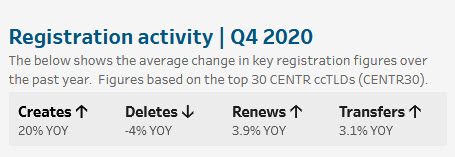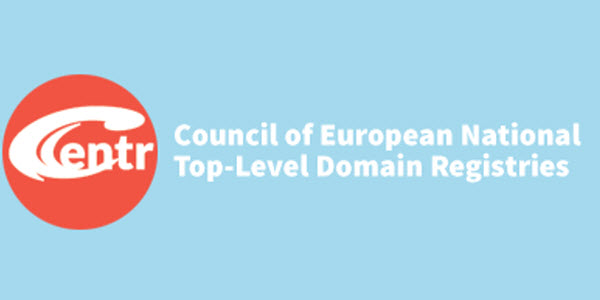New report says that 2020 was a historic year in that the median growth of European country-code domains (ccTLDs) reached a 6-year high of 4.4%.
The CENTRstats Global TLD Report Q4/2020 has been published and report covers the global status and registration trends in all top-level domains (legacy gTLDs, new gTLDs and ccTLDs), with an additional focus on the European ccTLD market.
Highlights from the report
- The median retail price for a European ccTLD domain is 10.8 EUR and remained largely stable over 2020;
- 44% of CENTR member ccTLDs have ‘high content’ domains, compared to 22% over the top 100 gTLDs;
- The median market share by local registrations is 64% in favour of the national ccTLD in Europe;
- There not as much growth in Asia Pacific ccTLDs compared with Europe;
- Growth has been slow among geographic gTLDs.
Quick glance statistics
- The median growth of European country-code domains (ccTLDs) in 2020 reached a 6-year high of 4.4% (CENTR30).
- Demand in new domain purchases peaked in November 2020 with an average increase of 27% year on year. Rates of domain deletions (or lapsed domains) decreased slightly, particularly toward the end of 2020.
- The median retail price for a European ccTLD domain is 10.8 EUR (ex-tax) for a 1 year registration. The price has remained stable over 2020 with just a small incline.
- The rate of ‘high content’ domains (domains that host functioning web pages and are not used for parking or have errors) is 44% for CENTR member ccTLDs1.
- The median market share by local registrations is 64% in favour of the national ccTLD and 49% based on popular websites in each country’s Alexa top 1000 websites2 .
 Registrations and growth drivers
Registrations and growth drivers
The median growth of European country-code domains (ccTLDs) in 2020 reached a 6-year high of 4.4% (CENTR30). The growth trend over the year was significant in that it is the first time since CENTR started formally recording data (2010) that such a sharp turnaround in the trajectory has been observed. The historic change was driven by two factors: an increased demand for new domains as well as reductions in the number of domains being deleted (whether from active deletes or expiries). Demand in new domain purchases peaked in November 2020 with an average increase of 27% year on year (CENTR30).
The underlying reason for the surges in demand is linked to lockdowns across Europe. As reported by CENTR, lockdowns across Europe due to the COVID-19 pandemic meant that for many small businesses, having a web presence was no longer considered as a bonus, but rather a tool for survival. The high demand also highlights the importance of country code domains to European businesses and citizens as a means of getting online. As lockdowns restricted the movement of people in a geographic sense, it is likely that the local focus of a country code domain may have been particularly appealing. A cake store moving from shop front to online for local deliveries would be wise to ensure they are easily identified as local – something a ccTLD can at least in part help achieve. This sort of local focus can be found in educational awareness activities from several country-code registries such as .ie (Ireland), .fr (France), .ca (Canada) among others.
Average retail prices (including any promotions) of the largest registrars3 of European ccTLDs shows no significant changes over 2020. This is important, as it implies the recent demand in domains is unlikely explained by price discounting.
The pdf version of the report can be found here.
 OnlineDomain.com Domain Name News & Opinions
OnlineDomain.com Domain Name News & Opinions


